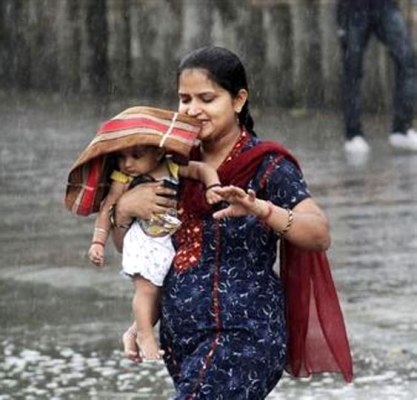 | « Back to article | Print this article |
 The state government, BMC and the town planning body Mumbai Metropolitan Region Development Authority had commissioned several impressive studies but the implementation of their recommendations is going at a snail’s pace.
The state government, BMC and the town planning body Mumbai Metropolitan Region Development Authority had commissioned several impressive studies but the implementation of their recommendations is going at a snail’s pace.
Officials of the BrihanMumbai Municipal Corporation said they would be in a spot if Mumbai receives 300 mm rain in a single day, notwithstanding the fact that they had taken a slew of measures in the wake of the 2005 deluge.
The civic body had come under attack in June this year after the city received 283 mm of rain in 24 hours.
Political parties and civil rights groups blamed BMC and successive state and central governments for doing precious little after the deluge a decade ago which had killed about 1,000 people.
The state government, BMC and the town planning body Mumbai Metropolitan Region Development Authority had commissioned several impressive studies but the implementation of their recommendations is going at a snail’s pace.
Jaijit Bhattacharya, partner at KPMG, told Business Standard: “Mumbai and all other cities lack a significant, comprehensive resilience plan.
"Post the July 2005 deluge, some steps were taken but the focus should have been laid on bringing back water and waste water channels to their original stage.
"It would have been done on a war-footing.”
On July 26, 2005, Mumbai had received 944 mm of rain in a day.
Interestingly, the civic body had undertaken the implementation of the much-debated BrihanMumbai Storm Water Drainage Project, which was initially proposed in 1985.
The project envisages upgradation of the city's 100-year old drainage system and construction of new pumping stations.
The Comptroller and Auditor General of India, in its report in 2013, castigated the civic body for the delays and cost escalation in the implementation of the project.
CAG in its report said the actual expenditure incurred on the project was Rs 1,764.6 crore (Rs 17.64 billion), overshooting the estimated cost of Rs 1,175.7 crore (Rs 11.75 billion).
However, only 27.6 per cent of the work was completed and it is estimated that the project will now cost Rs 2,708.89 crore (Rs 27.08 billion) more to complete.
Further, during the 2005 floods, the narrow Mithi river, filled with silt and garbage, couldn’t carry the water out to the sea, exacerbating an already bad situation.
Operations at the city’s Chhatrapati Shivaji International Airport were affected because of waterlogging on the runways.
The first and main runway was built across the Mithi river.
Over the years, the airport's boundaries expanded, pushing the river off its natural course.
Subsequently, MMRDA undertook the Mithi river cleaning project.
It is not complete yet.
The work involved is desilting, deepening and widening the river and constructing retaining walls.
An MMRDA official admitted that there has been cost escalation as it was to arrange for the resettlement and rehabilitation of the people staying along the banks of the river.
Image: A woman carries her child through a heavy rain shower. Photograph: Ajay Verma/Reuters
The image is used for representational purpose only